A. The Chronus Exhibition
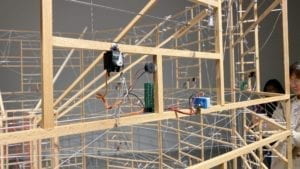
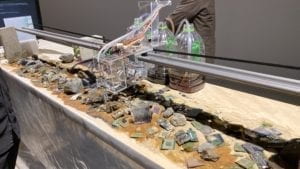
The Chronus exhibition has inspired me a lot. The art pieces are technology-based, and some of them are equipped with Arduino components. My previous learning about Arduino also helped me a lot to understand how the systems work. The most impressive exhibit for me is Beholding the Big Bang. It is a sculpture in which a motor drives a series of gears and the final gear will take 13.82 billion year to rotate once. This is one of the estimates for the age of the Universe since the big bang. The final gear will never turn, and is embedded in a block of concrete. In the description of this exhibit, there is a sentence that is inspiring for me. “The concrete is stillness—perhaps the imaginary moment before everything happened.” The concept of this art piece is so romantic, mysterious, and philosophical, which moved me deeply. It is not hard to conclude that the conception cannot be achieved if the exhibit is just a static image. While non-technology based art works can only provide the viewers with still pictures, technology based pieces can engage the viewers with movements, audios, and even opportunities of physical touch. In addition, various technologies also provide the creators with different tools to achieve the original conception. They can trigger imagination, enhance creativity, and have dynamic identities. From a viewer’s side, I found the technology-based art works more appealing. When I see a painting or a photograph, I will just stand in front of the work for several seconds, guess what it conveys, read the description, and then leave. However, when I see technology-based art works, I will be curious about how the systems work, what the implicit meanings are, and how the creators came up with these ideas. These works are more interesting, engaging, and compellingly attractive.
B. Research
I have researched three interactive projects online. The first one that I introduce here is not quite interactive from my perspective. According to its creators Mathias Maierhofer and Valentina Soana, ‘Self-Choreographing Network’ proposes a hybrid approach: a real-time, interactive design and operation process that enables the system to be self-aware, fully utilizing and exploring its kinetic design space for adaptive purposes. However, the interaction included in this project is between the work itself and the environment. That is to say, the effect of human behaviors is not the main point of this design. In my opinion, an interactive process must include a human participant, or it could only be described as a mobile art work that is for appreciation.
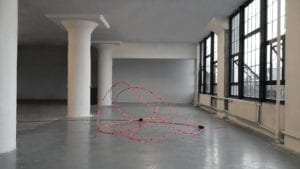
The second project is named as ‘Click Canvas’.187 Boxes of light serve as creative tools for the audience to create some images, and the color of each box are changed each time the audiences press it. There is no doubt that it is an interactive experience for the user, since they are the real controller of the whole system. However, from my perspective, the output of the process is a bit too simple. Although it is easy for the audience to understand how the interactive process works, they may soon get bored with the interactive process itself. That is, the output of the process is just the change of the light, and what the audience are truly interested with is their behavior of creating something, instead of what the device brings them.
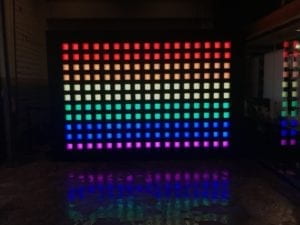
The third project, named as ‘Design I/O’, provides the most successful interactive experience from my perspective. ‘Design I/O’ is a robot that is playful and inquisitive. It can show a range of dynamic moods and actions that are triggered in response to whatever motions or gestures it detects. The interaction here is distinct. The users can move their whole bodies to interact with the robot, instead of only pressing a small button. The interaction shows some level of communication, and it provides several means of output. The users are truly engaged with the design, and enjoy the interactive process.
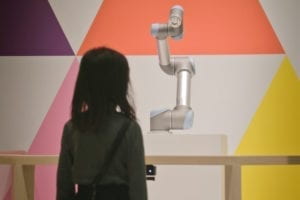
C. An Interactive Experience
I summarized my initial definition of interaction based on Crawford’s exact description of the interactive process. He says, “Interaction: a cyclic process in which two actors alternately listen, think, and speak” (5). I develop my ideas during the group project. In my opinion, interaction should be separated into two parts: physical interaction and emotional interaction. Emotional interaction involves emotions, humanistic feelings and aesthetic value. High-level interactivity should combine these two parts of interaction organically. My ideas about interaction also developed during the midterm project. In my individual reflection post, I wrote “a highly interactive device should allow the user to really engage in the interaction, instead of excluding them as the audience or actors”. My previous definitions of interaction thus formed into my current perception on a successful interactive experience. In my opinion, a successful interaction experience should contain the following four parts.
- The process of interaction should be clear to the users, so that they can get a basic sense of what they should do to interact with the device. It can be seen in both the second and the third projects that I mention above.
- The design of the interactive experience should provide the user with various means of interacting with the device. The “contact area” between the user and the device should be large. For example, when interacting with ‘Design I/O’, the users can change gestures or move to other locations to interact with the robot, instead of only pressing a small button.
- Various means of expression is needed, such as visuals and audios. The user can be truly engaged when receiving information with different senses.
- The user should gain some senses of accomplishment, pleasure, surprise or entertainment from the experience. In addition, the experience could be thought-provoking, which may reflect the facts in the real life.
References:
Crawford, “What Exactly is Interactivity,” The Art of Interactive Design, pp. 1-5.
Self-Choreographing Network: https://www.creativeapplications.net/processing/self-choreographing-network-cyber-physical-design-and-interactive-bending-active-systems/
Click Canvas:
https://www.creativeapplications.net/member-submissions/click-canvas/
Design I/O: https://www.creativeapplications.net/openframeworks/design-ios-mimic-putting-emotional-machines-within-arms-reach/